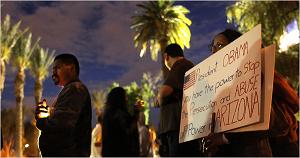The Los Angeles City Council could take a significant step in protesting Arizona’s crackdown on illegal immigration Wednesday when it considers up to $56 million in Arizona-related investments the city could boycott.The list includes airline service into Arizona and the harbor’s clean truck incentive program.Officials are recommending that the City Council suspend travel to the state, refrain from entering new contracts and review current ones for possible termination.
Los Angeles officials joined with other cities across the country in calling for an economic boycott of Arizona after lawmakers there passed a tough immigration law that critics say will lead to racial profiling.The law, which will take effect July 23, makes it a crime for unauthorized migrants to be in Arizona and requires police to check the immigration papers of those they suspect may be in the country illegally.The report was prepared by Chief Legislative Analyst Gerry F. Miller, who recommended that the council adopt a revised resolution that expresses city opposition to the use of federal funds to implement the Arizona law, saying it encourages racial profiling, violates constitutional guarantees of due process and equal protection and undermines federal authority over immigration.
The proposed resolution notes that the city imposed economic sanctions in the past to protest such actions as South Africa’s apartheid policies and Colorado’s 1992 repeal of local ordinances that banned discrimination based on sexual orientation.
“This is not just about Los Angeles; it’s a significant response to legislation that hurts a whole slice of the population,” said Councilman Ed Reyes, one of seven council members calling for a boycott. “We hope to create an economic ripple effect not only in dollars but also in sending a message to others concerning the discriminatory effect of this legislation.”
However, the Harbor Department and Los Angeles World Airports expressed concern about possible termination of their contracts with Arizona businesses. The Harbor Department, for instance, has four contracts with Arizona firms totaling $25.6 million, mostly involving a clean truck incentive program.Under the program, three Arizona firms have brought hundreds of newer short-haul trucks with significantly lower emissions into Southern California. The harbor’s $56-million program is projected to reduce port-related truck pollution 80% by 2012.
“The program has been phenomenally successful,” said Arley Baker, a port spokesman. “We don’t recommend rescinding the contracts due to adverse effects on the environment and public health.”Los Angeles World Airports has three equipment and maintenance contracts worth $77,000 and receives $22 million in revenue from two Arizona-based airlines US Airways and Mesa Air.”We need to do additional research into our ability to limit Arizona-based airlines from using LAWA airports,” said airport spokeswoman Nancy Suey Castles.
Reyes said he also supports a cautious approach to make sure the city would not be sued over any boycott action. The analyst’s report contains several caveats, such as refraining from entering new contracts with Arizona “to the extent practicable and in instances where there is no significant additional cost to the City nor conflict with the law.””We still need to be careful how we approach it so we aren’t vulnerable to legal actions that would have a whiplash effect on our general funds,” Reyes said.

